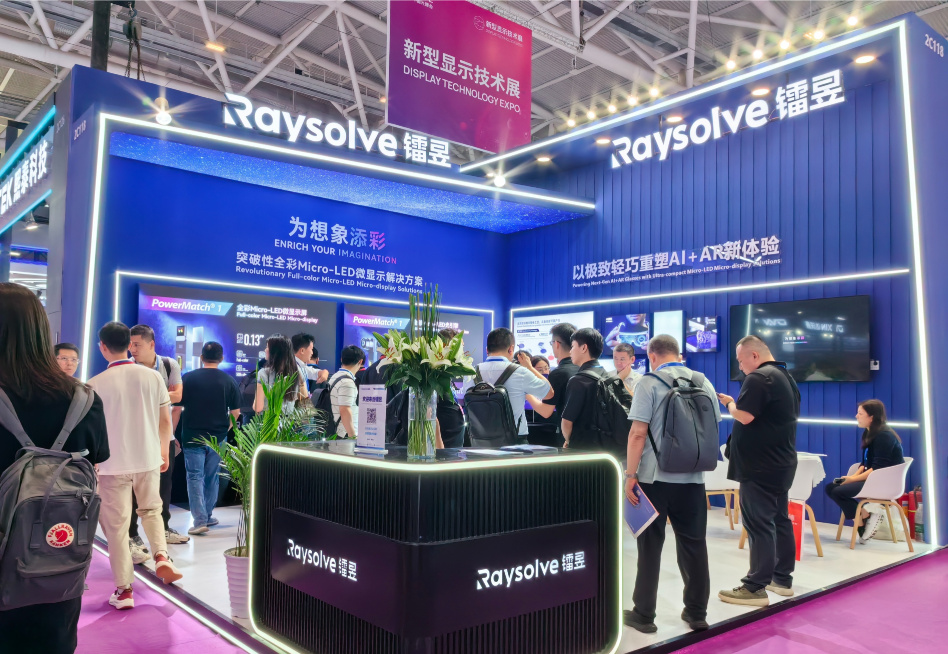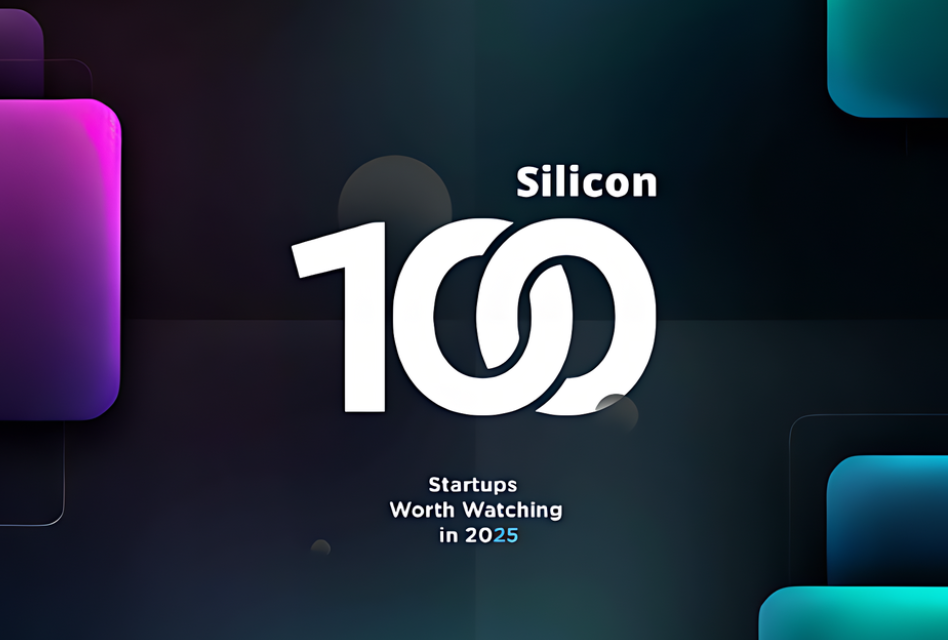Shenzhen – September 10, 2025 – At this year’s CIOE, smart glasses display technology took center stage. Raysolve showcased its PowerMatch® 1 series Micro-LED micro-displays, Light Engines, and full-color AR glasses, drawing strong interest from industry professionals.
The company’s monolithic full-color Micro-LED displays, powered by proprietary quantum dot photoresist (QDPR) technology, deliver exceptional performance – enabling a new phase of visual-intelligent glasses.
Voice-only AI glasses offer basic functionality, but lack visual interfaces, limiting interaction depth. Visual capability is now the central differentiator between product generations.
Over 80% of human information is processed visually, making AI-AR integration essential. AI acts as the “brain”; AR provides the “eyes.” Moving from voice-only to multimodal interaction isn’t just a tech upgrade – it’s a user experience revolution.
Micro-LED, with its small size, high brightness, and low power consumption, is the leading display solution. Full-color models support richer content than monochrome, improving not only aesthetics but also information clarity and usability – making glasses true personal assistants.
Raysolve’s QDPR tech uses a unique blend of quantum dots and photoresist to pattern red and green pixels onto blue Micro-LEDs via standard lithography. This full-flow semiconductor process ensures high precision and uniformity, supporting mass production.
This achievement stems from improvements in materials, LED processes, and optical design. Optimized QDPR increased light conversion efficiency; better blue GaN LEDs enhanced overall output; refined optical structures improved light extraction. Together, these advances significantly boosted red brightness and signal further gains ahead.
Traditional AlInGaP red Micro-LEDs lose efficiency at small sizes and are temperature-sensitive. In contrast, Raysolve’s GaN+QDPR solution offers higher brightness and color stability. GaN-based RGB pixels also use uniform processes and voltages, simplifying production.
Continued QDPR advances will further improve full-color Micro-LED brightness, stability, and yield – opening new possibilities for AR displays.
The PowerMatch® 1 series offers key specs for AI+AR glasses: a 0.13-inch display, 4μm pixel pitch, and 6,350 PPI density. It achieves 500,000 nits full-color brightness, 0.7lm light output, and 108.5% DCI-P3 color gamut.
Its breakthrough compact design features a full-color Light Engine measuring just 0.18cc – the industry’s smallest – meeting strict size and weight demands for glasses.
Notably, Raysolve exhibited the world’s first AR glasses prototype using monolithic full-color Micro-LED with SRG diffraction waveguides. This marks its first display in China after debuting at SID DisplayWeek in the U.S., signaling strong progress toward consumer AR applications.
This technology enables richer AI interactions – shifting from voice-only to visual feedback, and from single commands to integrated smart services. Raysolve is already sampling to customers and developing prototypes, accelerating commercialization.
Dr. Eddie Chong, Founder and CEO of Raysolve, said: “As AI and AR converge, smart glasses are evolving from voice assistants to multimodal intelligent devices. Raysolve’s full-color Micro-LED displays are key to enabling this visual transformation.”
The company’s monolithic full-color Micro-LED displays, powered by proprietary quantum dot photoresist (QDPR) technology, deliver exceptional performance – enabling a new phase of visual-intelligent glasses.
AI Growth Drives Smart Glasses Adoption
With multimodal AI models rapidly advancing, smart glasses have entered a key growth phase. Strong sales of Ray-Ban Meta models, plus new products from Xiaomi and RayNeo, are fueling what many call the “hundred-glasses battle.” In H1 2025, sales of consumer AI/AR glasses in China reached 262,000 units – up 73% year-on-year. Screenless AI glasses led this growth, surging 463%, reflecting strong market potential.Voice-only AI glasses offer basic functionality, but lack visual interfaces, limiting interaction depth. Visual capability is now the central differentiator between product generations.
Over 80% of human information is processed visually, making AI-AR integration essential. AI acts as the “brain”; AR provides the “eyes.” Moving from voice-only to multimodal interaction isn’t just a tech upgrade – it’s a user experience revolution.
Micro-LED, with its small size, high brightness, and low power consumption, is the leading display solution. Full-color models support richer content than monochrome, improving not only aesthetics but also information clarity and usability – making glasses true personal assistants.
QDPR Breakthrough Enhances Display Performance
Since introducing the first monolithic full-color Micro-LED display with QDPR in 2019, Raysolve has consistently led this field. The company has now achieved a new milestone: red light brightness exceeding 2 million nits using its QDPR technology. This leap improves full-color Micro-LED brightness and stability, enabling high-performance outdoor AR applications.Raysolve’s QDPR tech uses a unique blend of quantum dots and photoresist to pattern red and green pixels onto blue Micro-LEDs via standard lithography. This full-flow semiconductor process ensures high precision and uniformity, supporting mass production.
This achievement stems from improvements in materials, LED processes, and optical design. Optimized QDPR increased light conversion efficiency; better blue GaN LEDs enhanced overall output; refined optical structures improved light extraction. Together, these advances significantly boosted red brightness and signal further gains ahead.
Traditional AlInGaP red Micro-LEDs lose efficiency at small sizes and are temperature-sensitive. In contrast, Raysolve’s GaN+QDPR solution offers higher brightness and color stability. GaN-based RGB pixels also use uniform processes and voltages, simplifying production.
Continued QDPR advances will further improve full-color Micro-LED brightness, stability, and yield – opening new possibilities for AR displays.
Slim Design Supports Next-Gen Glasses
Raysolve’s monolithic full-color Micro-LED approach uses a first-principles design that optimizes performance and cost. Its core advantage is a wafer-level standardized process that integrates RGB production, avoiding complex multi-chip alignment and boosting consistency and scalability. This method reduces future mass-production costs through standardization.The PowerMatch® 1 series offers key specs for AI+AR glasses: a 0.13-inch display, 4μm pixel pitch, and 6,350 PPI density. It achieves 500,000 nits full-color brightness, 0.7lm light output, and 108.5% DCI-P3 color gamut.
Its breakthrough compact design features a full-color Light Engine measuring just 0.18cc – the industry’s smallest – meeting strict size and weight demands for glasses.
Notably, Raysolve exhibited the world’s first AR glasses prototype using monolithic full-color Micro-LED with SRG diffraction waveguides. This marks its first display in China after debuting at SID DisplayWeek in the U.S., signaling strong progress toward consumer AR applications.
This technology enables richer AI interactions – shifting from voice-only to visual feedback, and from single commands to integrated smart services. Raysolve is already sampling to customers and developing prototypes, accelerating commercialization.
Dr. Eddie Chong, Founder and CEO of Raysolve, said: “As AI and AR converge, smart glasses are evolving from voice assistants to multimodal intelligent devices. Raysolve’s full-color Micro-LED displays are key to enabling this visual transformation.”
Next article
Raysolve Recognized Again on EE Times’ Prestigious Silicon 100 List
July 25, 2025








